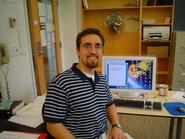
Isoprene (C5H8) is the second most common naturally occurring hydrocarbon in the atmosphere (methane, CH4, is the first). It is produced and released into the air by certain species of plants. Due to isoprene's high concentration in the atmosphere, it has a significant impact on many atmospheric processes, most notably its role as an essential precursor to ozone (O3). Although ozone in the upper layers of the atmosphere is essential to blocking harmful ultraviolet rays from the Sun, ozone in the lower layers of the atmosphere is a serious pollutant because it contributes to smog, acts as a greenhouse gas, and causes respiratory problems.
Marco Allodi '08 (Oriskany, N.Y.) is modeling the reaction of isoprene with hydroxyl radicals (OH+ ), the most prevalent oxidizer of unsaturated hydrocarbons in the atmosphere. This oxidation reaction is the beginning of the pathway that leads to ozone formation in the troposphere (the lowest layer of the atmosphere). Allodi is studying isoprene's reaction with hydroxyl radicals using computational methods. Various computer programs allow him to use quantum mechanical models to study the geometries of the molecules and the energies involved in the reaction pathway.
Allodi began this research project two summers ago, and, now, in his third summer of research, he is finalizing his experiments and readying his data for publication.
This summer, Allodi has also begun working on a new atmospheric chemistry project that involves radiative forcing, which can be loosely defined as the difference between the incoming radiation and outgoing radiation for a given system. A positive forcing (i.e. more incoming radiation) tends to warm the system while a negative forcing (i.e. more outgoing radiation) tends to cool it. Radiative forcing impacts the temperature of Earth and affects its weather. When solar radiation reaches Earth, some of it is absorbed by the planet and the atmosphere while the rest of it is radiated back into space.
For his second project, Allodi is studying how much energy stays in the atmosphere after solar energy strikes the Earth. The amount of energy that remains in the atmosphere can be affected by various factors, such as clouds that reflect radiation and greenhouse gases, such as carbon dioxide (CO2), that absorb it. In his newest project, Allodi is specifically studying small aerosols and water clusters in the atmosphere and modeling their radiative forcing. He says that this project may become his senior thesis.
Allodi, a chemical physics major and recipient of a Goldwater Scholarship, is a member of the Hamilton College Chemical Society, the choir, and the Spanish club. He also volunteers as a soccer coach for inner-city children from Utica's Cornhill area. Allodi is actively involved in the Tau Kappa Epsilon fraternity, serving as rush chair and chaplain. His summer research advisors are George Shields, Winslow Professor of Chemistry, and Karl Kirschner, co-director of the Center for Molecular Design.
-- by Nick Berry '09
Marco Allodi '08 (Oriskany, N.Y.) is modeling the reaction of isoprene with hydroxyl radicals (OH+ ), the most prevalent oxidizer of unsaturated hydrocarbons in the atmosphere. This oxidation reaction is the beginning of the pathway that leads to ozone formation in the troposphere (the lowest layer of the atmosphere). Allodi is studying isoprene's reaction with hydroxyl radicals using computational methods. Various computer programs allow him to use quantum mechanical models to study the geometries of the molecules and the energies involved in the reaction pathway.
Allodi began this research project two summers ago, and, now, in his third summer of research, he is finalizing his experiments and readying his data for publication.
This summer, Allodi has also begun working on a new atmospheric chemistry project that involves radiative forcing, which can be loosely defined as the difference between the incoming radiation and outgoing radiation for a given system. A positive forcing (i.e. more incoming radiation) tends to warm the system while a negative forcing (i.e. more outgoing radiation) tends to cool it. Radiative forcing impacts the temperature of Earth and affects its weather. When solar radiation reaches Earth, some of it is absorbed by the planet and the atmosphere while the rest of it is radiated back into space.
For his second project, Allodi is studying how much energy stays in the atmosphere after solar energy strikes the Earth. The amount of energy that remains in the atmosphere can be affected by various factors, such as clouds that reflect radiation and greenhouse gases, such as carbon dioxide (CO2), that absorb it. In his newest project, Allodi is specifically studying small aerosols and water clusters in the atmosphere and modeling their radiative forcing. He says that this project may become his senior thesis.
Allodi, a chemical physics major and recipient of a Goldwater Scholarship, is a member of the Hamilton College Chemical Society, the choir, and the Spanish club. He also volunteers as a soccer coach for inner-city children from Utica's Cornhill area. Allodi is actively involved in the Tau Kappa Epsilon fraternity, serving as rush chair and chaplain. His summer research advisors are George Shields, Winslow Professor of Chemistry, and Karl Kirschner, co-director of the Center for Molecular Design.
-- by Nick Berry '09
Posted July 5, 2007
